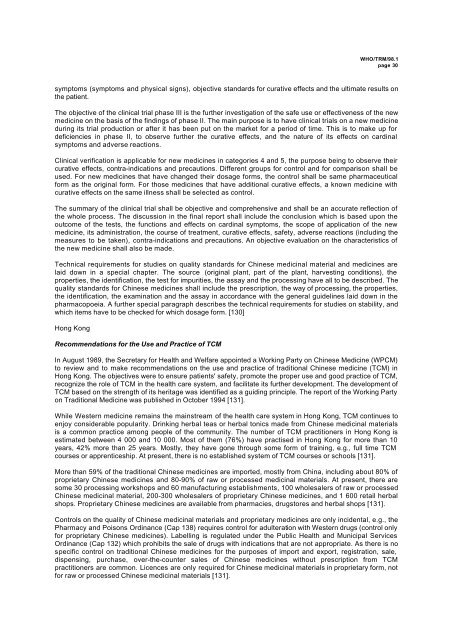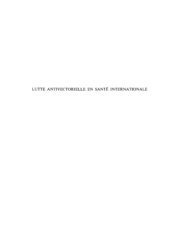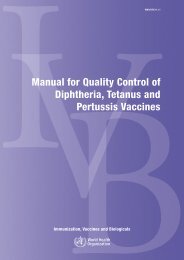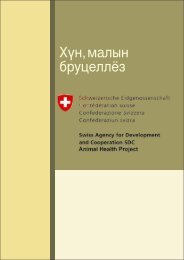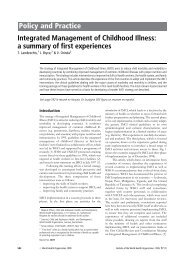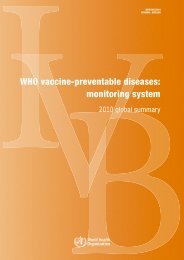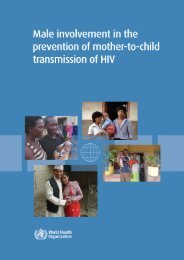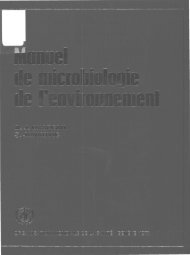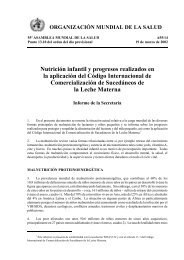Regulatory Situation of Herbal Medicines A worldwide Review
Regulatory Situation of Herbal Medicines A worldwide Review
Regulatory Situation of Herbal Medicines A worldwide Review
Create successful ePaper yourself
Turn your PDF publications into a flip-book with our unique Google optimized e-Paper software.
WHO/TRM/98.1page 30symptoms (symptoms and physical signs), objective standards for curative effects and the ultimate results onthe patient.The objective <strong>of</strong> the clinical trial phase III is the further investigation <strong>of</strong> the safe use or effectiveness <strong>of</strong> the newmedicine on the basis <strong>of</strong> the findings <strong>of</strong> phase II. The main purpose is to have clinical trials on a new medicineduring its trial production or after it has been put on the market for a period <strong>of</strong> time. This is to make up fordeficiencies in phase II, to observe further the curative effects, and the nature <strong>of</strong> its effects on cardinalsymptoms and adverse reactions.Clinical verification is applicable for new medicines in categories 4 and 5, the purpose being to observe theircurative effects, contra-indications and precautions. Different groups for control and for comparison shall beused. For new medicines that have changed their dosage forms, the control shall be same pharmaceuticalform as the original form. For those medicines that have additional curative effects, a known medicine withcurative effects on the same illness shall be selected as control.The summary <strong>of</strong> the clinical trial shall be objective and comprehensive and shall be an accurate reflection <strong>of</strong>the whole process. The discussion in the final report shall include the conclusion which is based upon theoutcome <strong>of</strong> the tests, the functions and effects on cardinal symptoms, the scope <strong>of</strong> application <strong>of</strong> the newmedicine, its administration, the course <strong>of</strong> treatment, curative effects, safety, adverse reactions (including themeasures to be taken), contra-indications and precautions. An objective evaluation on the characteristics <strong>of</strong>the new medicine shall also be made.Technical requirements for studies on quality standards for Chinese medicinal material and medicines arelaid down in a special chapter. The source (original plant, part <strong>of</strong> the plant, harvesting conditions), theproperties, the identification, the test for impurities, the assay and the processing have all to be described. Thequality standards for Chinese medicines shall include the prescription, the way <strong>of</strong> processing, the properties,the identification, the examination and the assay in accordance with the general guidelines laid down in thepharmacopoeia. A further special paragraph describes the technical requirements for studies on stability, andwhich items have to be checked for which dosage form. [130]Hong KongRecommendations for the Use and Practice <strong>of</strong> TCMIn August 1989, the Secretary for Health and Welfare appointed a Working Party on Chinese Medicine (WPCM)to review and to make recommendations on the use and practice <strong>of</strong> traditional Chinese medicine (TCM) inHong Kong. The objectives were to ensure patients' safety, promote the proper use and good practice <strong>of</strong> TCM,recognize the role <strong>of</strong> TCM in the health care system, and facilitate its further development. The development <strong>of</strong>TCM based on the strength <strong>of</strong> its heritage was identified as a guiding principle. The report <strong>of</strong> the Working Partyon Traditional Medicine was published in October 1994 [131].While Western medicine remains the mainstream <strong>of</strong> the health care system in Hong Kong, TCM continues toenjoy considerable popularity. Drinking herbal teas or herbal tonics made from Chinese medicinal materialsis a common practice among people <strong>of</strong> the community. The number <strong>of</strong> TCM practitioners in Hong Kong isestimated between 4 000 and 10 000. Most <strong>of</strong> them (76%) have practised in Hong Kong for more than 10years, 42% more than 25 years. Mostly, they have gone through some form <strong>of</strong> training, e.g., full time TCMcourses or apprenticeship. At present, there is no established system <strong>of</strong> TCM courses or schools [131].More than 59% <strong>of</strong> the traditional Chinese medicines are imported, mostly from China, including about 80% <strong>of</strong>proprietary Chinese medicines and 80-90% <strong>of</strong> raw or processed medicinal materials. At present, there aresome 30 processing workshops and 60 manufacturing establishments, 100 wholesalers <strong>of</strong> raw or processedChinese medicinal material, 200-300 wholesalers <strong>of</strong> proprietary Chinese medicines, and 1 600 retail herbalshops. Proprietary Chinese medicines are available from pharmacies, drugstores and herbal shops [131].Controls on the quality <strong>of</strong> Chinese medicinal materials and proprietary medicines are only incidental, e.g., thePharmacy and Poisons Ordinance (Cap 138) requires control for adulteration with Western drugs (control onlyfor proprietary Chinese medicines). Labelling is regulated under the Public Health and Municipal ServicesOrdinance (Cap 132) which prohibits the sale <strong>of</strong> drugs with indications that are not appropriate. As there is nospecific control on traditional Chinese medicines for the purposes <strong>of</strong> import and export, registration, sale,dispensing, purchase, over-the-counter sales <strong>of</strong> Chinese medicines without prescription from TCMpractitioners are common. Licences are only required for Chinese medicinal materials in proprietary form, notfor raw or processed Chinese medicinal materials [131].


